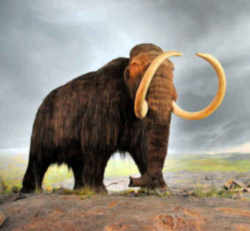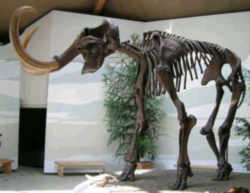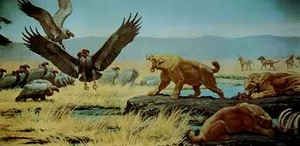Alaska State Fossil
Woolly Mammoth

(Mammuthus primigenius)
Adopted in 1986 per the 14th Legislature.
The Woolly Mammoth, (Mammuthus primigenius,) was adopted in 1986 per the 14th Legislature as Alaska state fossil.
These extinct creatures patrolled areas including Alaska's northern reaches and the Tanana River valley near Big Delta in the Interior. Archaeologists have found indications that prehistoric people worked with fossil tusks. Primitive hunters were sometimes successful in killing them for food. Gold miners sometimes wash mammoth tusks and teeth out of streambeds and hillsides. Visitors to the University of Alaska Museum in Fairbanks may touch a mammoth tooth on display.
Alaska State Fossil: Woolly Mammoth

The woolly mammoth first evolved in Eurasia and entered Alaska from Siberia over the Bering Land Bridge around 65,000 years ago. It dominated the grasslands of North America during periods of glaciation, but went extinct around 10,000 years ago.
This well known mammoth of the Ice Age was a cold climate dweller equipped with a thick layer of fat for insulation, and an exterior of long black hair hence the name wooly mammoths, and the color was primarily brown, though the shades of mammoth hair found by archeologists has been everything from golden to black. It was smaller than most mammoths, and had a hump of fat behind its domed head. It fed on low tundra vegetation such as grasses, sedges, and shrubs in which it scraped away snow and ice from with its ivory tusks. Much is known about their appearance because carcasses have been found preserved in frozen ground in Siberia, and wall pictures by stone-age artists can be seen today in ancient European caves. Woolly mammoths grew to about the size of present-day Asiatic elephants, possessed warm coats consisting of long, brown guard hairs and soft underwool, large curved ivory tusks, and knob-like heads.
Several well preserved remains have been found in Siberia and Alaska and cave paintings in Spain and France show depictions of the Wooly Mammoth as seen by early humans. Woolly mammoths roamed the northern plains for most of the last 2 million years or so until about 10,000 years ago. Mammoths died out at the end of the last ice age. No one really knows why, but scientists theorize that there just may not have been enough food to support them. They did have predators, including early man, but these were not plentiful enough or needy enough to hunt the mammoth to extinction.
Most of the 100 or so mammoths found to date appear to have gotten trapped and died in swamps or soft soil, or to have been buried by avalanches. The Jarkov Mammoth seems to have gotten stuck in mud in the bottom of a creek. Found on Siberia's Taimyr Peninsula in 1997 by a 9-year-old boy, this mammoth was about 47 years old when he died just over 20,000 years ago.
One of the best preserved Canadian specimens consists of most of an entire skeleton from Whitestone River in the Yukon Territory. It died there about 30,000 years ago, according to a radiocarbon date.
Characteristics
TIME - Late Pleistocene
RANGE - Europe / North America / Asia
DIET - Tundra vegetation
SIZE - 9 ft. (2.7 m) high
Alaska Statutes 2015
The law designating the woolly mammoth as the official Alaska state fossil is found in Alaska Statutes 2015 TITLE 44. STATE GOVERNMENT Chapter 44.09 STATE SEAL, FLAG, AND EMBLEMS Sec. 44.09.120. State fossil
TITLE 44. STATE GOVERNMENT
Chapter 44.09 STATE SEAL, FLAG, AND EMBLEMS
Sec. 44.09.120. State fossil.
HISTORY
(Sec. 2 ch 31 SLA 1986)
AS 44.09.120
Sec. 44.09.120. State fossil.
The woolly mammoth (Mammuthus primigenius) is the official state fossil.
Taxonomic Hierarchy: Woolly Mammoth
Kingdom:: Animalia
Phylum: Chordata
Class: Mammalia
Order: Proboscidea
Family: Elephantidae
Genus: Mammuthus
Species: Mammuthus primigenius
Synonyms:
Elephas primigenius Blumenbach, 1799
Mammonteus primigenius (Osborn, 1924)
Elephas boreus Hay, 1924
Mammuthus boreus (Hay, 1924)

Some states that lack a "state fossil" have nevertheless singled out a fossil for formal designation such as a state dinosaur, rock, gem or stone.







